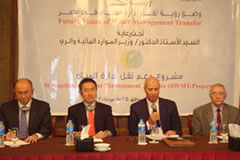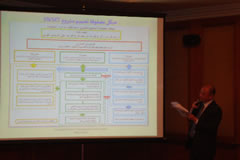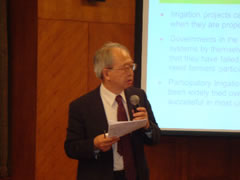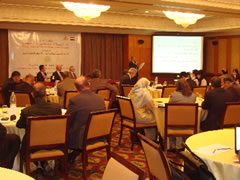- Home
- Technical Cooperation Projects
- Index of Countries
- Middle East
- Egypt
- Project for Strengthening Water Management Transfer
- Project News
- A Workshop was held for Development of a Roadmap on Water Management Transfer (WMT).
Project News
2015-04-01
A Workshop was held for Development of a Roadmap on Water Management Transfer (WMT).
The Project for Strengthening Water Management Transfer (SWMT Project) implemented a workshop on development of a roadmap on Water Management Transfer (WMT) in Cairo on March 25.
The total number of participants was 60, including decision makers of relevant departments in the Ministry of Water Resources and Irrigation (MWRI) and representatives of the Branch Canal Water Users' Association (BCWUA) in each of the three pilot sites.
The objectives of the workshop were to share the future vision on WMT, discuss it and get full support on development of the roadmap from the participants.
Although the Project will develop the roadmap to develop the WMT nationwide, it is necessary for all the stakeholders to integrate their recognition of the vision of the WMT into one and share it altogether.
In particular, it is important to discuss basic visions on dissemination of WMT including which activity should be transferred to the BCWUAs, what kind of support the government should give to them in WMT as well as what kind of goals should be set up for WMT to BCWUAs having various different situations.
In the beginning of the workshop, the project team explained the current situations of the project activities as well as the vision of the WMT to be achieved in Egypt.
As for the vision of the WMT, the project team explained that; ①it is an image of co-management to make the BCWUAs participate in water management as much as possible, while it is also important to establish a system in which all the stakeholders can cooperate together to enable the BCWUAs to enhance levels of their participation in various activities, ②the government needs to develop the guideline on roles and responsibilities of each related organization, while all the stakeholders should continuously make efforts to approach it, ③it is necessary to give to the BCWUAs sufficient motivation for their participation in water management in connection with allocation of the fund to rehabilitate their irrigation facilities because the WMT cannot be implemented only by capacity building of the BCWUAs and the Irrigation Advisory Services for which the SWMT Project has been currently working.
After the draft guideline on roles and responsibilities of each related organization including the BCWUAs as well as challenges and draft solutions in promotion of the WMT were explained by the Project, opinions about the contents of those presentations were exchanged by all the participants.
In exchange of opinions about the WMT, the vision of the WMT which was presented by the Project was basically accepted, but there were several different opinions about degrees of transferring roles and responsibility of each activity on WMT to the BCWUAs. Especially, regarding development of water distribution plan from branch to tertiary canals and operation of facilities, although the Project proposed to transfer responsibilities of those activities to the BCWUAs in the draft guideline, some participants said that it is technically difficult, whereas others agreed to that proposal with the technical support by the government.
Therefore, it was concluded at the end that the discussions on this matter be further continued even after the workshop to reach consensus.
After exchange of opinions, Dr. Masayoshi Satoh, Professor Emeritus at Tsukuba University, presented his recommendations on WMT to the participants.
Dr. Satoh mentioned that it is necessary for the government which has limited number of staff to implement water management by promoting famers' participation in water management as well as by playing its role as their supervisor.
Furthermore, by introducing Japanese experiences on WMT, he emphasized that in promoting famers' participation, there should be a system in which every stakeholder must be fairly treated and be able to participate in making significant decisions of water management.
We believe that by his recommendations, all the stakeholders who work to implement the WMT were enough encouraged and inspired.
In the workshop, we could not only get various different opinions about how to implement the WMT from many stakeholders, but also narrow down the points to be discussed.
Now that the basic concepts on the vision of the WMT were shared with the main stakeholders, the Project will soon start to develop the roadmap on WMT.
From now on, all the project members will continuously make efforts to implement every project activity so that the roadmap can be developed successfully.
 Opening ceremony (From right, Eng. Ahmed of CDIAS, Eng. Fathy, Head of Irrigation Department, Mr. Nakasone, Senior Representative of JICA Egypt, Eng. Naito, Chief Advisor of the SWMT Project.
Opening ceremony (From right, Eng. Ahmed of CDIAS, Eng. Fathy, Head of Irrigation Department, Mr. Nakasone, Senior Representative of JICA Egypt, Eng. Naito, Chief Advisor of the SWMT Project.
 Presentation by Eng. Naito.
Presentation by Eng. Naito.
 Recommendations by Dr. Satoh, Professor Emeritus at Tsukuba University.
Recommendations by Dr. Satoh, Professor Emeritus at Tsukuba University.
 Participants in the workshop.
Participants in the workshop.
- About JICA
- News & Features
- Countries & Regions
- Our Work
- Thematic Issues
- Types of Assistance
- Partnerships with Other Development Partners
- Climate Change / Environmental and Social Considerations
- Evaluations
- Compliance and Anti-corruption
- Science and Technology Cooperation on Global Issues
- Research
- JICA Development Studies Program / JICA Chair
- Support for the Acceptance of Foreign HRs / Multicultural and Inclusive Community
- Publications
- Investor Relations
